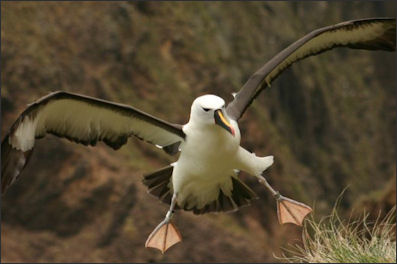SEABIRDS
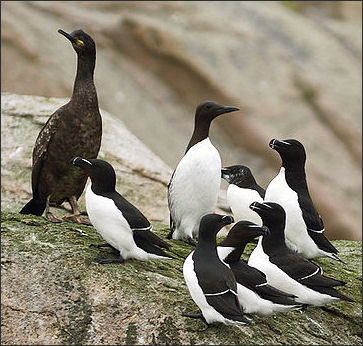 Seabirds (marine birds) are birds that are adapted to life in the sea or marine environments. They vary greatly in behavior, lifestyle and physiology however they often exhibit striking similarities and convergent evolution as they have to deal with the same environmental problems and feeding issues have resulted in similar adaptations such as webbed feet for swimming and long wings for soaring over the open ocean. The first seabirds evolved in the Cretaceous period (145 million to 66 million years ago). Modern seabird families emerged in the Paleogene Period (66 million to 23 million years ago). [Source: Wikipedia]
Seabirds (marine birds) are birds that are adapted to life in the sea or marine environments. They vary greatly in behavior, lifestyle and physiology however they often exhibit striking similarities and convergent evolution as they have to deal with the same environmental problems and feeding issues have resulted in similar adaptations such as webbed feet for swimming and long wings for soaring over the open ocean. The first seabirds evolved in the Cretaceous period (145 million to 66 million years ago). Modern seabird families emerged in the Paleogene Period (66 million to 23 million years ago). [Source: Wikipedia]
As a rule, seabirds live longer, breed later and have fewer young than other birds do. They invest a great deal of time and energy in their young and feed both at the ocean's surface and below it, and even feed on each other. Seabirds can be highly pelagic, coastal, or in some cases spend a part of the year away from the sea entirely.
Seabirds and humans have a long history together. The birds have provided food to hunters, guided fishermen to fishing stocks and led sailors to land. Many species are currently threatened by human activities, such as from oil spills, getting trapped in nets, and by climate change and severe weather. Conservation efforts include the establishment of wildlife refuges and adjustments to fishing techniques.
Seabird populations are one of the best ways to judge the health of marine ecosystems. The European Commission wants to be able to monitor them as barometers for the overall health of the sea. Some seabird species are critically endangered due to a lack food but also to climate change and the destruction of coastal habitats where they compete with humans for space along the water's edge.
See Separate Articles: SHOREBIRDS: CHARACTERISTICS, BEHAVIOR AND TYPES ioa.factsanddetails.com ; SEAGULLS: CHARACTERISTICS, BEHAVIOR AND ATTACKS ioa.factsanddetails.com ; TERNS: CHARACTERISTICS, BEHAVIOR, SPECIES AND ARCTIC TERN MIGRATIONS ioa.factsanddetails.com ; GANNETS: CHARACTERISTICS, BEHAVIOR, NESTING AND DIVING ioa.factsanddetails.com ; FRIGATE BIRDS: CHARACTERISTICS, BEHAVIOUR, FLYING AND COURTING ioa.factsanddetails.com ; SHEARWATERS AND PETRELS ioa.factsanddetails.com ; PELICANS: CHARACTERISTICS, BEHAVIOR, FEEDING AND NESTING ioa.factsanddetails.com ; ALBATROSSES: CHARACTERISTICS, NESTING AND THREATS ioa.factsanddetails.com ; LARGE — WANDERING AND ROYAL —ALBATROSSES: CHARACTERISTICS, SUBSPECIES AND COURTSHIP ioa.factsanddetails.com ; PENGUINS: CHARACTERISTICS, HISTORY AND SWIMMING ioa.factsanddetails.com ; ENDANGERED PENGUINS: DECLINING NUMBERS, THREATS ioa.factsanddetails.com ; PENGUIN BEHAVIOR, SEXUALITY AND YOUNG ioa.factsanddetails.com ; EMPEROR PENGUINS: CHARACTERISTICS, BEHAVIOR, SWIMMING ioa.factsanddetails.com
Websites and Resources: Animal Diversity Web (ADW) animaldiversity.org; National Oceanic and Atmospheric Administration (NOAA) noaa.gov; Encyclopedia of Life eol.org; Smithsonian Oceans Portal ocean.si.edu/ocean-life-ecosystems ; MarineBio marinebio.org/oceans/creatures
Seabird Migrations
Many species of sea bird are famous for undertaking long annual migrations, crossing the equator or circumnavigating the Earth in some cases. Arctic terns have the longest migration of any bird. Every year they fly around 40,300 kilometers (25,000 miles) between the Arctic and the Antarctic and back, with much of the flying done over water. They nests in Arctic regions. When the young are old enough to fly the whole family flies south to Antarctica. The tern’s wings are long and powerful and they can make steady headway even against strong headwinds. See Terns
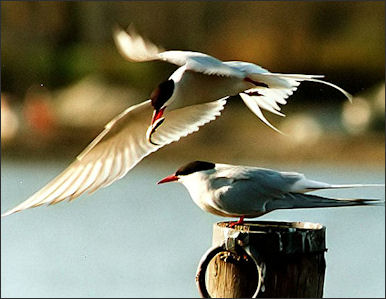
Arctic terns Arctic terns are not the only sea birds that undertake long migrations. Ian Poiner of Australia has tracked puffins that make a nearly 64,000-km circle every year from New Zealand to Japan, Russia, Alaska, Chile and back in what the census calls the “longest-ever electronically recorded migration.” Tags placed on seabirds record levels of ambient lights that can be translated into longitude and latitude.
A bar-tailed godwith, a species of sea bird, was recorded flying 11,400 kilometers from Alaska to New Zealand in 2008 with no rest or food. The red knot is a sandpiper-like bird that flies 15,000 kilometers between Tierra del Fuego and the Arctic. Critical to their trip is a stopover in Delaware Bay to feast on horseshoe crab eggs, The birds know when and where to find the eggs, in some cases doubling their weight after they feed on them. But these days horseshoe crabs and horseshoe crab eggs, which are taken by conch and eel fishermen as bait, are harder to find and a critical way station for the red knots is threatened.
Seabird Colonies
Most species nest in colonies, which can vary in size from a few dozen birds to millions. Many birds that spend a considerable amount of time at sea nest in huge colonies on isolated islands or remote cliffs or peninsulas. Seabird colonies occur exclusively for the purpose of breeding; non-breeding birds will only collect together outside the breeding season in areas where prey species are densely aggregated. Numbers at seabird colonies can fluctuate greatly and many are in decline. The claims of large colonies below may have been true in the past but may not be true now.
Seabirds nest together in crowded colonies not because sites are scare but rather because it easier for the birds to protect their young in packed conditions. Gulls and other sea birds are threatened from the air by other birds and from the ground by animals like foxes. When an intruder shows up near a nesting site gulls rally together and harass the intruder until it leaves. Under similar circumstances an individual gull would have a hard time repelling the invader. Even under these condition only around 15 percent of eggs produce fledglings but this rate is higher than solitary nests where success rate in near zero.
Among the largest — if not THE largest — colony of seabirds is the sooty shearwater (Puffinus griseus) colony on Isla Guaf, an island southwest of Chiloé Island and northwest of Chonos Archipelago, Chile. An estimated 4 million birds nest there above 150 meters above sea level under a forest without an understory. Sooty Shearwaters on Isla Guafo prefer north and western slopes that protect them from the predominantly southerly winds. In recent years the wintering population off California and New Zealand have declined noticeably. In Chile, knowledge of the population is limited. Investigations on Isla Guafo were carried out during two seasons (March 2004 and April 2005). [Source: “Sooty Shearwater (Puffinus griseus) on Guafo Island: the largest seabird colony in the world” by Reyes-Arriagada, Ronnie; Campos-Ellwanger, Paulo; Schlatter, Roberto P.; Baduini, Cheryl, from the journal Biodiversity and conservation, 2007]
Colonies of over a million birds have been recorded, both in the tropics (such as Kiritimati in the Pacific) and in the polar latitudes (as in Antarctica). Zavodovski Island in Antarctica is home to one million to one and a half million Chinstrap Penguins, the largest penguin colony on earth. There are more than one million penguins at Punta Tombo, Argentina, it the largest penguin colony in South America.
Kiritimati (also known as Christmas Island) an atoll in Pacific Ocean, in Kiribati was once home to around 1 million wedge-tailed shearwaters (Puffinus pacificus) — among the very largest breeding colonies in the world — but since 1982–1983 the number of birds has been in decline St Kilda, an isolated Scotland archipelago situated 64 kilometers (40 miles) west-northwest of North Uist in the North Atlantic Ocean, is said to be — or was — home to a million seabirds, many of them northern gannets. Relatively nearby Bass Rock is home to 75,000 pairs (2014) of northern gannets compared to 60,000 pairs St. Kilda (2013).
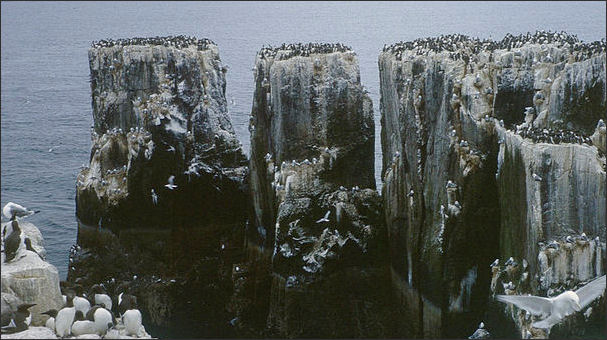
Bird colony in the Farne Islands Pinnacles
Shorebirds
Shorebirds are like their name says birds that hang out along the edge of oceans or other waterways, generally on mud flats or sandy beaches. Many are waders that have long legs for wading and long bills for picking out and probing prey. Some species have sensory nerve ending at the end of their bills that help them locate prey in the mud or sand. Their wings are built for fast quick getaways rather than gliding and soaring.
Shorebirds are primarily birds of ocean coasts, especially adapted to feeding on tidal flats and marshes, which abound in the small invertebrates they thrive on. At this time of year, however, the newly planted rice paddies, filled with shallow water clear enough to see the bottom, look and function much like tidal flats. Many species of shorebird migrate. Protecting them is difficult because their wintering grounds, breeding grounds and stopover points are all like links in a chain and if one of them fails the whole chain can fall apart.
In coastal areas, shorebirds like to work the edges of waves. They don’t mind getting their feet wet but not their bodies. They often work the beaches in flocks. Some members are always on the lookout for predators. They are often busiest at low tide, when the beach stretches out the furthest. Shorebirds extract large quantities of small mollusks from sandbanks and mud flats when the tide retreats. The animals are extracted from the shells with a flick of the head.
See Separate Article: SHOREBIRDS: CHARACTERISTICS, BEHAVIOR AND TYPES ioa.factsanddetails.com
Gulls
Gulls, or colloquially seagulls, are seabirds of the family Laridae in the suborder Lari. They are most closely related to terns and skimmers and distantly related to auks and waders. Gulls have webbed feet and are good swimmers. Diverse and adaptive, they eat almost every thing: worms, crustaceans, chicks, other gull’s chicks, grain crops, dead seals, garbage. They also have large mouths and throats and have been observed eating entire large starfishs in one bite. In 1829, a naturalist clubbed one gull on the head. The bird then proceeded to discourage an entire auk — a foot-long seabird now extinct. An autopsy revealed another auk in its stomach. Gulls are among the few birds that can easily snatch thrown food out of the air.
Gulls are incredibly diverse and adaptive birds, always ready to take advantage of any source of easy food. They push in with the pigeons and pintails whenever someone scatters a handful of potato chips or some other unhealthy snack. Experienced gull feeders, however, simply throw their fare high into the air. The gulls are the only birds capable of snaring a cheese doodle in midair. [Source: Kevin Short, Daily Yomiuri, February 5, 2007]
Gulls form same sex partnerships when they can not find opposite sex partners. Up to 15 percent of Western gull pairs are females, who build joint nests and take turns watching over unfertilized eggs and woo each other with gifts of food. Sometimes one member will mate with a male but the female pair will raise the young.
See Separate Article: SEAGULLS: CHARACTERISTICS, BEHAVIOR AND ATTACKS ioa.factsanddetails.com
Terns
Terns are mostly sea birds. They have webbed feet and are good swimmers. Terns are sometimes group together with gulls. Terns are smaller than gulls and have wings and feet that are designed for flying. They tend to be plunge divers capable of diving deeper in the water than gulls. Terns primarily eat small fish they catch by diving into the surface of the sea. A male courting a female, brings her one or two fish, carrying them crossways in her bill. Downy tern chicks are almost invisible crouching in the brush. When an intruder approaches, sometimes the adult flies off and leaves the chicks alone. The chicks don't move regardless of how close the predator approaches
Terns are slender, lightly built birds with long, forked tails, narrow wings, long bills, and relatively short legs. The sexes are identical in appearance, but young birds are readily distinguishable from adults. Terns have a non-breeding plumage, which usually involves a white forehead and much-reduced black cap. Terns are longer-billed, lighter-bodied, and more streamlined than gulls, and their long tails and long narrow wings give them an elegance in flight. Male and female plumages are identical, although the males can be two to five percent larger than the females and often has a relatively larger bill. Sea terns have deeply forked tails, and at least a shallow "V" is shown by all other species. [Source: Wikipedia +]
Terns are long-lived birds and are relatively free from natural predators but most species are declining in number due directly or indirectly to human activities, including habitat loss, pollution, disturbance, and predation by introduced mammals. The Chinese crested tern is critically threatened and three other species are classed as endangered. International agreements provide a measure of protection, but adults and eggs of some species are still used for food in the tropics. The eggs of two species are eaten in the West Indies because they are believed to have aphrodisiac properties. +
See Separate Article: TERNS: CHARACTERISTICS, BEHAVIOR, SPECIES AND ARCTIC TERN MIGRATIONS ioa.factsanddetails.com
Gannets

gannets
Gannets are sea birds famous for their extraordinary diving ability. Feeding alone or in flocks, the dive like missiles from great heights to capture fish and squid. Sometimes gannets will pursue their prey underwater, moving with half open wings and powerful feet.
Gannets and boobies are grouped together in Sulidae bird family comprised of one genus (Sula) and 10 species. Sulids are medium to large birds (.72 to 3.6 kilograms, ; 64-100 centimeters). Gannets are distributed throughout tropical and subtropical oceans. Some sulids are pelagic (open ocean) while others are inshore marine birds. Breeding areas include offshore islands and continental coastlines. Sulids may live for 10-20 or more years. [Source: Laura Howard, Animal Diversity Web (ADW) /=]
In some tropical areas gannets are sometimes hunted for eggs, meat, and feathers. At the turn of the century, the Northern Gannet colony in the Gulf of St. Lawrence, which had over 100,000 pairs, was nearly eradicated by human culling. The colony was reduced to 500 pairs by 1932. Fortunately, by 1984 the colony had recovered to 6,700 pairs. One gannet species is including in the International Union for Conservation of Nature (IUCN) Red List. The Cape Gannet (Sula capensis) is listed as 'Vulnerable'. The main threats include: habitat destruction; human collection of eggs, chicks, and adults; entanglement in fishing gear and overfishing of prey fish by commercial industries. /=\
See Separate Article: GANNETS: CHARACTERISTICS, BEHAVIOR, NESTING AND DIVING ioa.factsanddetails.com
Shearwaters and Petrels
Shearwaters and petrels belong to a group called Procellariidae, known in the past as tubenoses. They are the most widely distributed of all bird species, ranging from 250 kilometers inland in the Antarctic to the nearest pieces of land to the North Pole. They also migrate great distances. Shearwaters tagged by the Census of Marine Life’s Tagging of Pacific Predators (TOPP) project off New Zealand made a 262-day, 39,790-mile round-trip journey in a figure-eight pattern, the longest animal migration ever recorded electronically at the time.
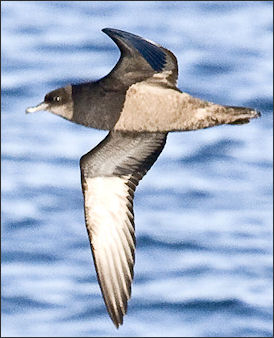
Short-tailed shearwater Shearwaters and petrels are a large family of birds. They are divided into four groups: 1) fulmars (cold water birds found mostly in the southern hemisphere); 2) prions (southern hemisphere birds, smaller in size than fulmars; 3) gadfly petrels (a group with 30 or species that nest underground in large colonies); 4) true shearwaters (a group with 23 species that have long, thin bills adapted for catching fish and zooplankton underwater).
Many shearwaters and petrels live on remote islands or remote locations where predators are not present. Most lay their eggs in burrows. Many establish huge colonies. True shearwaters mostly visit their burrows at night. Shearwaters and petrels lay their eggs and brood their young in holes. During the day their breeding areas are quiet places as they adults are either at sea feeding or in their holes with their eggs or chicks, which offer some protection from the skuas and gulls that harass them. Shearwater and petrel adults extract oil from the sea creatures they eat and regurgitate in the mouths of their young. They also squirt oil at intruders. The oil often gets all over the place. This combined with the smell of the birds themselves makes their colonies very smelly places.
See Separate Article: SHEARWATERS AND PETRELS ioa.factsanddetails.com
Pelicans
Pelicans are water birds with long bills and extendable pouches with a capacity of 12 liters. They weigh up to eight kilograms, making them among the largest flying birds, and have an awkward, ungainly appearance and have been described as feathered basset hounds. Pelicans are remarkably adapted for their water environment. They have air sacs under their skin that give them remarkable buoyancy and help stay upright in even the waviest conditions. [Source: Mel White, National Geographic, June 2006]
There are seven species of pelican. They have existed more or less in their present form for at least 20 million years. Pelicans tend to stay close to the shore rather than venture out into to the open ocean. Most pelicans nest and feed near fresh water and can feed in both fresh and sea water. The brown pelican is the only true marine pelican. It is the only one that dives for food. They others mostly sit on the surface and dip their bills into the water to feed. The word pelican originates from the Greek word pelakan, meaning "axe". In classical times, the word was applied to both pelicans and woodpeckers.
Pelican tend to live no longer than 20 years. Some pelicans have a nine foot wingspan, which is more suited more for soaring and gliding and picking up air currents than flapping, and gives them remarkable endurance and grace in the air. Many pelicans migrate between summer nesting areas and wintering areas to the south. They often fly in a V formation. Like bicycle riders, these birds use less energy if they follow in the slip stream of a bird front of them. As the group flies forward the bird at the front gets tired and goes the back and is replaced by another leader.
See Separate Article: PELICANS: CHARACTERISTICS, BEHAVIOR, FEEDING AND NESTING ioa.factsanddetails.com
Albatrosses
yellow nose albatross
Albatrosses are very large sea birds with extraordinary capabilities. Carl Safina wrote in National Geographic, “An albatross is the grandest flying machine on Earth. An albatross is bone, feather, muscle, and the wind. An albatross is its own taunt longbow, the breeze its bowstring, propelling its body forward. An albatross is an art deco bird, striking of pattern, clean of line, epic in travels, heroically faithful. A parent albatross may fly more than 10,000 miles to deliver one meal to its chick...If you could travel millions of miles fueled by clean, self-renewing energy, you’d be an albatross.” [Source: Carl Safina, National Geographic, December 2007; Kennedy Warne, Smithsonian magazine, September 2007; Tui Dek Roy and Mark Jones, Natural History magazine, April 2009]
There are 21 species of albatross and they fall into three groups: 1) the great albatrosses (the wandering albatross, royal albatross and the nearly extinct Amsterdam albatross); 2) the mollymawks (with nine species); and 3) sooty albatrosses (two species). Mollymawks and sooty albatrosses are smaller than the great albatrosses. Mollymawk comes from a Dutch word meaning “foolish gull.” If all the species combined there are around 3 million albatrosses.
Most albatrosses live in the Southern Hemisphere. There are large breeding colones in the Crozet Islands in the Indian Ocean, on South Georgia in the South Atlantic Ocean, and Campbell, Chatham and Snares islands in New Zealand. The largest colonies in the Northern Hemisphere are on a series of uninhabited island near Midway west of Hawaii, a few island near Japan, the Galapagos islands and some islands in the North Pacific.
See Separate Article: ALBATROSSES: CHARACTERISTICS, NESTING AND THREATS ioa.factsanddetails.com ; LARGE — WANDERING AND ROYAL —ALBATROSSES: CHARACTERISTICS, SUBSPECIES AND COURTSHIP ioa.factsanddetails.com
Threats to Seabirds
Seabirds are impacted by a variety of human-related activities including oil spills, fisheries interactions, contaminants, disturbances, and habitat destruction. In California, for example, nesting and migrant seabird populations are significant resources with colonies throughout the state. Over time, these populations have been impacted by a variety of man-made sources, including oil spills, gill-net and other fisheries, various contaminants, habitat destruction, introduced predators, low-flying aircraft, close approaches by motorized and non-motorized boats, humans on foot, and general ocean and coastal users. [Source: NOAA]
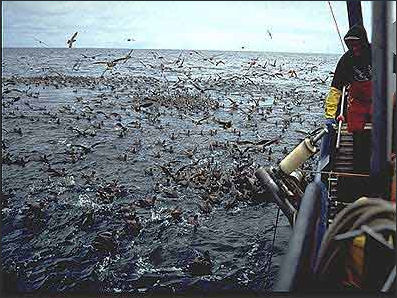
Seabirds and longliners These disturbances can cause nesting seabirds to flee from and abandon their nests, leaving eggs or chicks exposed to predators, or causing eggs to fall from the nest. In some cases, disturbances can cause complete breeding failure of a seabird colony, and ultimately may cause colony abandonment. These disturbance events can result in a reduction of the long-term health and survival of affected marine species, and when coupled with changing oceanic conditions and other human-induced stressors, cumulative small impacts can impart large-scale harm.
Seabirds suffer from overfishing which deprives them of food and commercial fishing methods which trap and kill them. In the 1960s when herring stocks in the Norwegian Sea crashed puffins had a hard time reproducing and their population crashed by 64 percent An estimated 300,000 seabirds are believed to be killed after being lured by baited hooks from long lines and then pulled underwater and drowned. The birds can be saved if the hooks are weight to drop them to depths the birds can not reach.
When Fish Supplies Drop by Two Thirds, Seabird Birth Rates Plummet
From gannets to seagulls, puffins to penguins, all seabirds suffer the same drop in birth rates when the supply of fish drops to less than a third of maximum capacity. Below the critical level of one third of the fish biomass, the birds — and the stability of the entire ecosystem — come under threat. [Source: Institut de Recherche pour le Développement (IRD), Science News, February 28, 2012]
These were the findings of an international study on the relationships between predators and prey in seven ecosystems around the world, published in the December 23, 2011 issue of Science magazine and coordinated by Philippe Cury, an Institut de Recherche pour le Développement (IRD) researcher. Based on nearly 450 cumulative years of observation, the research team compared the growth in fish supplies and the reproductive patterns of 14 species of coastal birds. These birds mainly feed on sardines, anchovies, herring and prawns, all of which are victims of over fishing. Below the critical level of one third of the fish biomass, the birds — and the stability of the entire ecosystem — come under threat.
The research team compared almost 450 years' worth of data from all over the world to see how the supply of fish correlated with the reproduction of seabirds. To do so, the scientists concentrated on 14 species of birds in seven ecosystems around the globe. The species selected feed mainly on sardines, anchovies, herrings and other small coastline fish that fishermen regularly catch and whose populations are under pressure. Each of the ecosystems was studied for periods ranging from 15 to 40 years; and the study showed that it generally takes 13 years of data to form an accurate notion of what the maximum fish supply is in a given ecosystem.
All bird species showed the same response, the team reported, the number of fledglings per breeding pair started to decline when the abundance of forage fish dropped below one-third of the maximum observed amount. "The biggest surprise was the consistency of the relationship," says co-author Ian Boyd, a mammalogist at the University of St. Andrews in the United Kingdom. "It bowled us all over." [Source: Erik Stokstad, Washington Post, December 22, 2011]

Seabirds enhance coral reef productivity and functioning in the absence of invasive rats Nature nature.com
How Overfishing Threatens Seabirds
From the Arctic to Antarctica and from the Atlantic to the Pacific, when the supply of fish is reduced, seabirds stop reproducing. Previous studies had uncovered the relationships between the availability of food to birds and their reproductive rates, but this new international study has just made the discovery of a critical level of supply of fish below which the stability of the bird population is endangered. [Source: Institut de Recherche pour le Développement (IRD), Science News, February 28, 2012]
Among gannets, terns, puffins, seagulls and penguins if fish supplies drop below a third of their maximum size, then the number of baby birds born drops precipitously. When amount of their prey falls below sufficiency, seabirds fail to reproduce. Yet above this level, their reproduction rate doesn't increase. Abundance of food supply doesn’t produce the expected result — more chicks — as other factors limit reproduction, such as the fact that nesting areas fill up quickly.
Boyd told the Washington Post that once prey become too scarce, hunting probably becomes inefficient and the birds lack enough food to successfully raise as many young. Although seabirds are adapted for the vicissitudes of life — forage fish numbers have large natural fluctuations — seabirds populations may decline when fishing depresses levels for many years in a row. "It's a corrosive effect," Boyd says. "Keep one-third for the birds" — that would be a useful guide to managing forage fisheries so that seabird populations remain resilient, the authors say. Fisheries biologist Steven Murawski of the University of South Florida in Tampa says that a properly managed fishery will maintain at least this much anyway in order to ensure the sustainability of the fish themselves. Nevertheless, he likes the motto, as it "gets at the notion that we need to leave a healthy margin of fish in the water. It surely is a great bumper sticker!" [Source: Erik Stokstad, Washington Post, December 22, 2011]
The December 2011 study published Science makes it plain that over fishing endangers the survival of higher-level predators such as birds. In fact, they are in direct competition with human fishermen: both groups consume about 80 million tonnes of fish per year. Small bait which are used to make meal and oils in fish farming — such as sardines, anchovies, herring, smelt and capelin — make up 30 percent of today's catch worldwide. As global demand rises, these findings make it possible, at last, to achieve a standard against which to measure the sustainable management of fish, so as to sustain populations of seabirds, over the long term.
Image Sources: Wikimedia Commons, NOAA
Text Sources: Animal Diversity Web (ADW) animaldiversity.org; National Oceanic and Atmospheric Administration (NOAA) noaa.gov; Wikipedia, National Geographic, Live Science, BBC, Smithsonian, New York Times, Washington Post, Los Angeles Times, The New Yorker, Reuters, Associated Press, Lonely Planet Guides and various books and other publications.
Last Updated May 2023


